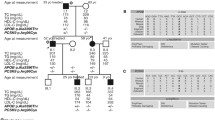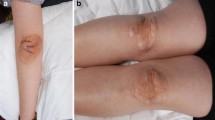Abstract
Familial hypercholesterolemia (FH), an autosomal dominant inherited disorder resulting in increased levels of circulating plasma low-density lipoprotein (LDL), tendon xanthomas and premature coronary artery disease (CAD), is caused by defects in the LDL receptor gene (LDLR). Three widespread LDLR alterations not causing FH (c.1061-8T>C, c.2177C>T and c.829G>A) and one mutation (c.12G>A) with narrow geographical distribution and thought to cause disease were investigated. In an attempt to improve knowledge on their origin, spread and possible selective effects, estimations of the ages of these variants (t generations) and haplotype analysis were performed by genotyping 86 healthy individuals and 98 FH patients in Spain for five LDLR SNPs: c.81T>C, c.1413G>A, c.1725C>T, c.1959T>C, and c.2232G>A; most patients carried two of these LDLR variants simultaneously. It was found that both the c.1061-8T>C (t = 54) and c.2177C>T alterations (t = 62) arose at about the same time (54 and 62 generations ago, respectively) in the CGCTG haplotype, while the c.12G>A mutation (t = 70) appeared in a CGCCG haplotype carrying an earlier c.829G>A alteration (t = 83). The estimated ages of selectively neutral alterations could explain their distribution by migrations. The origin of the c.12G>A mutation could be in the Iberian Peninsula; despite its estimated age, a low selective pressure could explain its conservation in Spain from where it could have spread to China and Mexico, since the sixteenth century through the Spanish/Portuguese colonial expeditions.
Similar content being viewed by others
References
Alharbi KK, Aldahmesh MA, Spanakis E, Haddad L, Whittall RA, Chen XH, Rassoulian H, Smith MJ, Sillibourne J, Ball NJ, Graham NJ, Briggs PJ, Simpson IA, Phillips DI, Lawlor DA, Ye S, Humphries SE, Cooper C, Smith GD, Ebrahim S, Eccles DM, Day IN (2005) Mutation scanning by meltMADGE: validations using BRCA1 and LDLR, and demonstration of the potential to identify severe, moderate, silent, rare, and paucimorphic mutations in the general population. Genome Res 15:967–977
Antonarakis SE, the Nomenclature Working Group (1998) Recommendations for a nomenclature system for human gene mutations. Hum Mutat 11:1–3
Bourbon M, Alves AC, Medeiros AM, Silva S, Soutar AK, on behalf of the investigators of the Portuguese FH study 1 (2008) Familial hypercholesterolaemia in Portugal. Atherosclerosis 196:633–642
Bourbon M, Duarte MA, Alves AC, Medeiros AM, Marques L, Soutar AK (2009) Genetic diagnosis of familial hypercholesterolaemia: the importance of functional analysis of potential splice-site mutations. J Med Genet 46:352–3577
Carlson CS, Eberle MA, Rieder MJ, Yi Q, Kruglyak L, Nickerson DA (2004) Selecting a maximally informative set of single-nucleotide polymorphisms for association analyses using linkage disequilibrium. Hum Genet 74:106–120
Castillo S, Reyes G, Tejedor D, Mozas P, Suarez Y, Lasuncion MA, Cenarro A, Civeira F, Alonso R, Mata P, Pocovi M, Spanish Group of FH (2002) A double mutant [N543H+2393del9] allele in the LDL receptor gene in familial hypercholesterolemia: effect on plasma cholesterol levels and cardiovascular disease. Hum Mutat 20:477
Cebrián JA (2002) La aventura de los Godos. Circulo de Lectores, Barcelona, p 204
Cenarro A, Jensen HK, Casao E, Civeira F, González Bonillo J, Rodríguez Rey JC, Gregersen N, Pocoví M (1998) Identification of recurrent and novel mutations in the LDL receptor gene in Spanish patients with familial hypercholesterolemia. Mutations in brief no. 135. Online. Hum Mutat 11:413
Chabás A, Gort L, Montfort M, Castelló F, Domínguez MC, Grinberg D, Vilageliu L (1998) Recurrence of the D409H mutation in Spanish Gaucher disease patients: description of a new homozygous patient and haplotype analysis. J Med Genet 35:775–777
Chang JH, Pan JP, Tai DY, Huang AC, Ph Li, Ho HL, Hsieh HL, Sc Chou, Lin WL, Lo E, Chang CY, Tseng J, Su MT, Lee-Chen GJ (2003) Identification and characterization of LDL receptor gene mutations in hyperlipidemic Chinese. J Lipid Res 44:1850–1858
Chaves FJ, Real JT, Garcia-Garcia AB, Civera M, Armengol ME, Ascaso JF, Carmena R (2001) Genetic diagnosis of familial hypercholesterolemia in a South European outbreed population: influence of low-density lipoprotein (LDL) receptor gene mutations on treatment response to simvastatin in total, LDL and high-density lipoprotein cholesterol. J Clin Endocrinol Metab 86:4926–4932
Defesche J, Kastelein JJ (1998) Molecular epidemiology of familial hypercholesterolemia. Lancet 352:1643–1644
Den Dunnen JT, Antonarakis SE (2000) Mutation nomenclature extensions and suggestions to describe complex mutations: a discussion. Human Mutat 15:7–12
Durst R, Colombo R, Shpitzen S, Avi LB, Friedlander Y, Wexler R, Raal FJ, Marais DA, Defesche JC, Mandelshtam MY, Kotze MJ, Leitersdorf E, Meiner V (2001) Recent origin and spread of a common Lithuanian mutation, G197del LDLR, causing familial hypercholesterolemia: positive selection is not always necessary to account for disease incidence among Ashkenazi Jews. Am J Hum Genet 68:1172–1188
Ekström U, Abrahamson M, Sveger T, Sun XM, Soutar AK, Nilsson-Ehle P (2000) Expression of an LDL receptor allele with two different mutations (E256K and I402T). Mol Pathol 53:31–36
Goldstein JL, Hobbs HH, Brown MS (2001) Familial hypercholesterolemia. In: Scriver CR, Beaudet AL, Sly WS, Valle D (eds) The metabolic and molecular basis of inherited disease, 8th edn. McGraw-Hill, New York, pp 2863–2913
Graham CA, Wright WT, McIlhatton BP, Young IS, Nicholls DP (2006) The LDLR variant T705I does not cause the typical phenotype of familial hypercholesterolaemia. Atherosclerosis 188:218–219
Heath KE, Whittal RA, Miller GJ, Humphries S (2000) I705 variant in the low density lipoprotein receptor gene has no effect on plasma cholesterol levels. J Med Genet 37:713–715
Hobbs HH, Brown MS, Goldstein JL (1992) Molecular genetics of the LDL receptor gene in familial hypercholesterolemia. Hum Mutat 1:445–466
Holla ØL, Nakken S, Mattingsdal M, Ranheim T, Berge KE, Defesche JC, Leren TP (2009) Effects of intronic mutations in the LDLR gene on pre-mRNA splicing: Comparison of wet-lab and bioinformatics analyses. Mol Genet Metab 96:245–252
Jensen HK, Jensen LG, Hansen PS, Faergeman O, Gregersen N (1996) High sensitivity of the single-strand conformation polymorphism method for detecting sequence variations in the low-density lipoprotein receptor gene validated by DNA sequencing. Clin Chem 42:1140–1146
Morral N, Bertranpetit J, Estivill X, Nunes V, Casals T, Giménez J, Reis A, Varon-Mateeva R, Macek M Jr, Kalaydjieva L, Angelicheva D, Dancheva R, Romeo G, Russo MP, Garnerone S, Restagno G, Ferrari M, Magnani C, Claustres M, Desgeorges M, Schwartz M, Schwartz M, Dallapiccola B, Novelli G, Ferec C, de Arce M, Nemetti M, Kere J, Anvret M, Dhal N, Kadeshi L (1994) The origin of the major cystic fibrosis mutation (delta F508) in European populations. Nat Genet 7:169–175
Mozas P, Cenarro A, Civeira F, Castillo S, Ros E, Pocovi M (2000) Mutation analysis in 36 unrelated Spanish subjects with familial hypercholesterolemia: identification of 3 novel mutations in the LDL receptor gene. Hum Mutat 15:483–484
Mozas P, Castillo S, Tejedor D, Reyes G, Alonso R, Franco M, Saenz P, Fuentes F, Almagro F, Mata P, Pocoví M (2004) Molecular characterization of familial hypercholesterolemia in Spain: identification of 39 novel and 77 recurrent mutations in LDLR. Hum Mutat 24:187
Pimstone SN, Sun XM, du Souich C, Frohlich JJ, Hayden MR, Soutar AK (1998) Phenotypic variation in heterozygous familial hypercholesterolemia: a comparison of Chinese patients with the same of similar mutations in the LDL receptor gene in China or Canada. Arterioscler Thromb Vasc Biol 18:309–315
Rannala B, Bertorelle G (2001) Using linked markers to infer the age of a mutation. Hum Mutat 18:87–100
Rannala B, Reeve JP (2001) High-resolution multipoint linkage-disequilibrium mapping in the context of a human genome sequence. Am J Hum Genet 69:159–178
Rannala B, Reeve JP (2003) Joint Bayesian estimation of mutation location and age using linkage disequilibrium. Pacific Symposium on Biocomputing, Lihue, Hawaii, USA, 8:526–534, 3–7 January 2003. http://helix-web.stanford.edu/psb03/#humvar (accessed 17 February 2010)
Robles-Osorio L, Huerta-Zepeda A, Ordóñez ML, Canizales-Quinteros S, Díaz-Villaseñor A, Gutiérrez-Aguilar R, Riba L, Huertas-Vázquez A, Rodríguez-Torres M, Gómez-Díaz RA, Salinas S, Ongay-Larios L, Codiz-Huerta G, Mora-Cabrera M, Mehta R, Gómez Pérez FJ, Rull JA, Rabès JP, Tusié-Luna MT, Durán-Vargas S, Aguilar-Salinas CA (2006) Genetic heterogeneity of autosomal dominant hypercholesterolemia in Mexico. Arch Med Res 37:102–108
Sanchez-Cerezo S (ed) (1995) Atlas histórico universal. El Pais-Aguilar, Madrid, pp 44–45, 91, 95, 103, 113 and 139
Slimane MN, Pousse H, Maatong F, Hammami M, Ben Farhat MH (1993) Phenotypic expression of familial hypercholesterolemia in central and southern Tunisia. Atherosclerosis 104:153–158
Sun XM, Patel DD, Webb JC, Knight BL, Fan LM, Cai HJ, Soutar AK (1994) Familial hypercholesterolemia in China. Identification of mutations in the LDL-receptor gene that result in a receptor–negative phenotype. Arterioscler Thromb 14:85–94
Tejedor D, Castillo S, Mozas P, Jiménez E, López M, Tejedor MT, Artieda M, Alonso R, Mata P, Simón L, Martínez A, Pocoví M, on behalf of the Spanish FH group (2005) Reliable low-density DNA array based on allele-specific probes for detection of 118 mutations causing familial hypercholesterolemia. Clin Chem 51:1137–1144
Tremblay M, Vezina H (2000) New estimates of intergenerational time intervals for the calculation of age and origins of mutation. Am J Hum Genet 66:651–658
Yamamoto T, Davis CG, Brown MS, Schneider WJ, Casey ML, Goldstein JL, Rusell DW (1984) The human LDL receptor: a cysteine-rich protein with multiple Alu sequences in its mRNA. Cell 39:27–38
Zaykin DV, Meng Z, Ehm MG (2006) Contrasting linkage-disequilibrium patterns between cases and controls as a novel association-mapping method. Am J Hum Genet 78:737–746
Acknowledgments
The authors thank Dr. D. Savva (University of Reading, UK) for his help with the English manuscript. This study was funded by Grants from the Spanish Ministry of Health FIS PI06/0365 and RTIC C06/01(RECAVA: Cooperative Cardiovascular Disease Research Network). The authors also thank CIBERER (Biomedical Network Research Centre on Rare Diseases).Ethical standards: The authors declare that the experiments carried out in this study comply with the current Spanish laws.
Conflict of interest statement
The authors declare that they have no conflict of interest.
Author information
Authors and Affiliations
Corresponding author
Additional information
Communicated by S. Hohmann.
Electronic supplementary material
Below is the link to the electronic supplementary material.
Rights and permissions
About this article
Cite this article
Tejedor, M.T., Cenarro, A., Tejedor, D. et al. Haplotype analyses, mechanism and evolution of common double mutants in the human LDL receptor gene. Mol Genet Genomics 283, 565–574 (2010). https://doi.org/10.1007/s00438-010-0541-8
Received:
Accepted:
Published:
Issue Date:
DOI: https://doi.org/10.1007/s00438-010-0541-8




